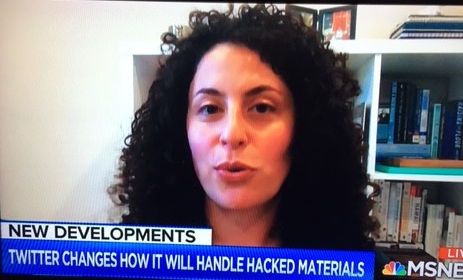Remote On-Camera Interviews During a Pandemic- Part 2
Lighting
and Audio Tips
By Joanne Stevens with Christien Methot and Marc Hoppe
Lighting!
I’ve watched what looked like an explosion of a ball of light on someone’s
chest..
I’ve listened to someone marveling how half her face and body
were darker on one side..
I’ve listened to someone wondering if he
had just one bright light aimed at his face…
Can I give you the best advice? No. I’m sorry! It’s not my area of expertise. But please meet Christien Methot www.d1ny.com . Christien is a colleague who helps me light my training space. He has fallen deep into the ‘remotes from home’ demand given the pandemic; his first client was his wife. Christien was born with the mantra ‘Lighting is Everything’ embossed on his heart. Whether you are being interviewed in your bucolic get-away, your bedroom, living room, or kitchen, we are all individually as important to him as his biggest clients.
Christien- take it away!
Thanks Joanne.
As a professional lighting designer for television and live events for over 30 years, I find myself more than ever preaching about the importance that light plays when we communicate with one another.
Lighting yourself properly for video interviews and conferences signals to others that you care what people think about you and that you want people to notice you and hear what you have to say.
Here are some basic practices that can help you stand out in the crowd by being better lit.
Daylight makes us all look great, and we could all use the dose of vitamin D these days. Position yourself so that you are sitting directly in front of a window- facing it. Preferably you’ll have a solar shade on it to soften the light.
Try to avoid a strong source of light from behind you which puts you in silhouette and makes it very hard to see you.
The same goes for not having the sunlight or artificial light source from only one side. It puts the other side of your face in shadow and makes it equally hard to see and understand you.
If you do not have the option of daylight you can try to position 2 small desk lamps, one from the left and one from the right of your computer screen. You want the lights to be directly next to your screen- close to your face at about the height of your nose. These lights can be a range of things from LED task lights that can aim in all directions to a more decorative table lamp with a warm LED bulb and a white shade to soften the light. Try to avoid ones that are a strong narrow beam of light, they are hard to control.
The lights you choose should
have a dimmer built into the lights so you can really tune your look.
Some Screenshots to Consider


Thanks Christien!
And now…..
Audio!
Q.- Take away the visuals and lighting- and what do we have?
A.- The technology that allows us to verbally share our wisdom and
discoveries.
NO SMALL THING.
Hence I now have the pleasure of introducing Marc Hoppe, marc.hoppe@gmail.com, another terrific professional with whom I work.
Marc is a freelance sound mixer who has been working in television and video for 25 years. He has worked in in virtually every aspect of production, including documentary, news, news magazine, sports features, corporate, and reality. This year, due to COVID, Marc’s been establishing technical protocols for conducting interviews via Zoom and other streaming services.
Both Marc and I are eager to share his remote audio advice- so let’s dive in via my questions!
What’s the best overriding audio advice you can give to all the people who are now being interviewed from their homes? What are a few common mistakes that you find folks making?
When being interviewed from home, you want to project clarity and confidence, and there are several things you can do to help that. A few of the common mistakes I see people making during at-home interviews are keeping poor posture, speaking too quickly, and speaking too loudly, and there are easy fixes to these issues.
The biggest culprit for poor posture is looking down at a laptop or webcam. Get your screen or camera up to eye level so you’re looking straight ahead at it. It’s a more flattering angle for you, but it also doesn’t compress the throat and larynx, which affects the voice. Hum a consistent tone and raise and lower your head to mimic looking at a laptop on a desk versus looking straight ahead and you’ll hear what I’m talking about.
Looking straight ahead also facilitates taking deeper breaths, which engages the diaphragm and helps to slow down your speech. Slowing down your speech adds clarity and projects confidence to your responses. It doesn’t matter what your message is if your audience can’t understand it or if they miss something because you’re talking too quickly.
Whether it’s on a Zoom call with friends or an at-home interview, people often feel the need to speak louder, in an unnatural way, to account for the perceived distance. Bear with me as this gets a little bit inside baseball and technical, but essentially, it boils down to this: The camera being used for the broadcast shot is not necessarily the same camera being used to feed the Zoom to interview you. While you may be seeing and hearing the image sent from the built-in camera and microphone from the journalist’s laptop, the tv audience at home will see the traditional head and shoulders shot from the studio cameras. The laptop camera is a much wider angle than the broadcast camera, making it appear as if the journalist is much further away from you. When we perceive that further distance, we tend to speak up to compensate, but here’s the pro tip: speak to the interviewer as if they’re seated across the desk from you, not across the room.
For those who don’t mind the look of headphones, would you say this is the best bet for audio clarity?
Let’s be honest, laptop speakers are tinny sounding at best and never do a great job of replicating the voice. The last thing you want to do in an interview is miss the question. Whether cabled headphones, cabled ear buds, or Bluetooth ear buds, having the speaker delivered right into your ear is going to lend itself to more clarity on their end, and reduce the urge to speak up to compensate for the perceived ‘distance’ between you. Having a more intimate sound coming to you also fosters a more natural speaking voice, helping to avoid the ‘speaking-louder ‘compensation.
Follow-up from there: earbuds- is it better if they’re plugged into the computer? Anything special to know about the ear buds?
Plugging ear buds into the computer is probably the safest way to minimize the chance of dropouts, but it also shows the unattractive headphone cable. If you’re comfortable using Bluetooth ear buds, I’d recommend that. An added bonus with ear buds is the built in microphone in close proximity to the mouth, and the distance between the mouth and the microphone never varies, lending a consistent sound.

I tend to use external speakers with an audio cable into my computer.. do I get a thumbs up for this?
You absolutely get a thumbs up for this- on board computer speakers are cheap and they don’t sound great. Any upgrade on audio fidelity reduces the chance of mis-hearing someone, or missing a question altogether.
My mic is part of my external camera, which is hooked onto my monitor; I don’t seem to get complaints and when I hear myself on recordings it seems pretty clear. Do you recommend a separate mic from the one that comes built into computers?
I absolutely recommend any mic that isn’t built into the computer, even if it’s part of an external webcam. When you have a camera with a mic clipped onto your monitor, you’re speaking directly at the microphone, rather than at one the size of a pinhole, buried somewhere discreetly around your keyboard. The webcam mic, at eye level, is going to be a significant improvement over any built in mic.
How about that problem of voices dissipating into the room and sounding almost ‘echo-y’ ? I know it has to do with the acoustics of their space- but are there some things they can do to make the audio ‘sharper’?
Virtually all of the streaming platforms are default set to automatic gain control for the microphones, meaning that they use an algorithm to boost quieter sounds and reduce louder ones, to fit into a compressed dynamic range. What does that mean? Essentially it means that when you’re not talking, it hears the other sounds in the room and boosts them up, whether that be a cat fountain in the background, or your neighbor's landscaping crew across the street.
Minimize or eliminate other noise, keep doors and windows closed, and reduce sound reflections in the room. We all know what speaking in an empty room with no carpeting sounds like- it echoes and is reverberant, which reduces clarity. Hang curtains, keep a rug under your chair, and use any soft, sound-absorbing material to reduce reflections in reverberant spaces.
Should people be asking for mics that have certain specifications or make certain assurances?
Since most people don’t have audio interfaces, look for USB powered and connected microphones. These are easy to setup and use, essentially plug and play, and computers recognize them instantly. One caveat is to go into the audio preferences tab of whatever streaming service you’re using and making sure that the microphone that you are using is the one that is selected.
Many USB microphones offer features that you’ll probably never use, but one thing you do want to look for is a cardioid pickup pattern. A cardioid pickup pattern is basically like an upside down heart shape, or an inverted apple, with the microphone where the stem would be. The pickup pattern is wide enough to pick up your voice when the mic is on a table in front of you, out of frame, while reducing the noise from outside that pick up pattern. Think of a cardioid pick up pattern on a mic like a beach ball- keep your mouth within a beach ball’s distance from the mic and you’re in the sweet spot!
Do you think a wired lavalier mic clipped onto their clothing would work better?
I think the benefits of using a lavalier mic clipped onto clothing are outweighed by the potential risks. While clipping a lav onto a blazer or jacket is a simple thing, it becomes less simple when wearing a t-shirt, button down, or dress. Personally, I feel that seeing the wire dangling looks sloppy, and wiring yourself elegantly is not always the easiest thing to do. For at-home interviews, I’d recommend sticking with wither the USB tabletop mic, the earbuds mic, or the mic built into an external webcam, as long as the clarity is there.
####
… And there you have it! I hope the above advice from Christien and Marc will help dissipate much of the confusion and anxiety that abounds. As I love to remind myself: you can’t be good at everything!
Good luck! And please watch for more tips in my next blog.
